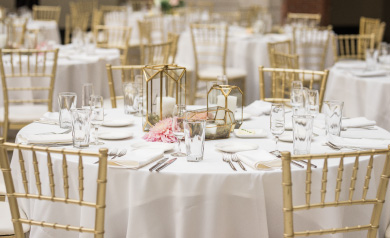(888) 435-4336 | Mon-Fri, 8am-8pm ET


After investing in tablecloths for your home or business, preserving your investment is important. See our handy tips below on how to take care of your tablecloths so they continue to spark joy for you and your guests for years to come.
Always wash polyester tablecloths on the delicate or gentle cycle, and use a front-load washer or an agitator-free top-load washer when possible. Large tablecloths can wrap around the agitator and put extra stress on the fabric (and extra stress on you trying to untangle it from the washer).
Wash tablecloths of the same color together to protect against the unlikely occurrence of the dye running. Also, wash in cold water, unless there are large greasy food stains. Then, pre-treat with dish detergent and wash in warm water.
Dry cleaning is safe for our Polyester Tablecloths and even our Cotton Napkins.
Always dry polyester tablecloths on the delicate or gentle cycle, then remove them from the dryer when they are still SLIGHTLY damp. This will allow you to more easily iron the tablecloths.
Polyester tablecloths need to be ironed before using in order to create a professional presentation of your table or tables. Here’s the best way to get them crease-free for your big day.
First, place a clean bedsheet on the floor under your ironing board. Tablecloths are large pieces of fabric, and the sheet keeps the dangling ends of your tablecloth clean and off the floor.
You’ll need to choose the highest setting your fabric can handle. Polyester tablecloths should be ironed on the synthetic-blend setting which is usually a medium heat (100% cotton can handle higher heat while delicates need very low heat).
Test the heat setting first on an inside seam to ensure the heat is correct.
To best ensure a fabulous presentation (and reduce the risk of damaging your tablecloth), iron on the reverse side of the tablecloth in back and forth motions. Avoid circular motions which tend to stretch the fabric. For stubborn creases, wet the area with a spray bottle first. If wrinkles are stubborn, you can also try steaming to relax the fabric fibers and get the toughest wrinkles out.
A little TLC when storing your tablecloths will reduce your time and effort making them presentable the next time you need to use them.
Use dry-cleaning hangers (the ones with cardboard struts used for pants) to minimize creases. Very gently fold your tablecloth into thirds or quarters and drape them over the hanger strut. Use one tablecloth per hanger.
If you prefer to fold and stack your tablecloths, make sure that they are completely dry before folding to prevent deep creases. Also, if you do fold and stack, you will need to iron them before their next use.
Always wash spandex tablecloths on the delicate or gentle cycle, and use a front-load washer or an agitator-free top-load washer when possible. Large tablecloths can wrap around the agitator and put extra stress on the fabric (and extra stress on you trying to untangle it from the washer).
Wash tablecloths of the same color together to protect against the unlikely occurrence of the dye running. Ensure that only tablecloths are washed together to avoid snags (i.e., no zippers, no buttons). Also, wash in cold water, unless there are large greasy food stains. Then, pre-treat with dish detergent and wash in warm water.
Dry cleaning is not safe for our Spandex Tablecloths. Also, chlorine bleach destroys spandex fibers. If you must use bleach, use oxygen-based bleach such as Oxi-Clean or Clorox 2.
Never place spandex tablecloths in a hot clothes dryer. The heat can permanently wrinkle or damage the material. Instead, hang your spandex tablecloths to drip-dry away from direct heat and sun or dry flat. If quicker drying is necessary, only use a very low temperature on a machine dryer and check the garment frequently.
Never use fabric softener or dryer sheets with spandex tablecloths, as they can leave a residue that will dull the finish and attract bacteria.
Your spandex tablecloth is wrinkle-resistant, and heat can ruin the spandex fibers. Don’t iron your spandex tablecloths.
A little TLC when storing your tablecloths will reduce your time and effort making them presentable the next time you need to use them.
Use dry-cleaning hangers (the ones with cardboard struts used for pants) to minimize creases. Very gently fold your tablecloth into thirds or quarters and drape them over the hanger strut. Use one tablecloth per hanger.
If you prefer to fold and stack your tablecloths, make sure that they are completely dry before folding.
Now that you know all about tablecloth sizes and quantity, it’s time to find the perfect tablecloths for your big event. Shop below and enjoy our free and fast shipping. Happy shopping!